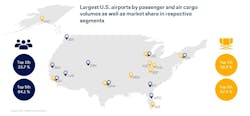Airports by the Thousands: Developing a Niche-Based Business Model, Positions U.S. Regional Airports to Conquer the Challenges Ahead
The network of airports, airfields and landing strips in the United States is vast – the success and prosperity of regional and general aviation airports rests on their ability to develop niches and become leaders in their fields.
Great numbers make U.S. the largest aviation market in the world
Statistics of U.S. aviation are a great read, ranking the country first among all global markets. The United States is the country with the highest passenger numbers and air freight per year. It has by far the most air traffic movements. The world’s largest airlines and airports all operate in the U.S.
More than 24,000 landing facilities yield for another record: no other country in the world has come near this number of airports. The vast majority of about 14,400 airports are in private-use and 3,300 are included in the federal administration’s National Plan of Integrated Airport Systems (NPIAS), considered to be essential for the air traffic infrastructure of the U.S.
The large hubs grow, the small develop slow
The fact that most U.S. airports achieve low levels of traffic, revenues and utilization applies to almost 89 percent of the country’s air traffic infrastructure. Regional airports nationwide feel the pressure to develop positively and profitably among the dense competition.
At 522 airports in the U.S. commercial air services accounted for 1.8 billion passengers in 2019. Hub airports consolidate the traffic: America’s top 50 passenger hubs handle 84.1 percent of traffic. The remaining nine out of ten airports fight for a passenger market of just over 15 percent. In cargo, the tendency for concentration is even more distinct: the total volume of 33.1 million tons of cargo in 2019 went through only 141 U.S. airports. The 50 largest cargo hubs handled 87.9 percent of all air freight traffic.
Unfavorable conditions: Aircraft sizes increase, airline numbers decrease
The industry’s developments are not in favor of regional airports, forcing them to invest time, energy and money to attract and retain airlines.
With the average number of passengers per flight in the U.S. growing from 73 in 2009 to 96 ten years later, airlines utilize larger aircraft to reduce unit costs per seat. The consequences are a widely practiced demise of aircraft in the segment of up to 50 seats that represent the market size of many rural airport communities for adequate frequencies.
And while planes get bigger, the number of potential airline customers for commercial services declines. The overall consolidation in the U.S. airline market, impedes regional airports’ aspirations to sustainably develop commercial services.
Federal support can lead to positive development
The U.S. Department of Transportation has set up various grant programs for regional airports – to develop route networks, improve infrastructures or cover expenses from the coronavirus pandemic. By making use of the financial aid provided, small airports can evolve commercial activities in the air traffic sector to operate more profitably and secure their position to be on the future map of the NPIAS.
The Essential Air Service (EAS) for airline route funding and the recently issued Small Community Air Service Development Program (SCASDP) helps regional airports in recovering route services that have been reduced or suspended through the COVID-19 crisis. Together with the Airport Coronavirus Response Grant Program and the Airport Improvement Program (AIP), regional airports can avail themselves of the needed financial support to align their businesses for the future.
Specialization in the niche segments of aviation and overarching businesses
It is unlikely regional airports in rural areas will turn into hubs, yet by specializing in a niche of the air traffic sector, smaller airports can develop a competitive edge. A thorough analysis of the catchment area, examination of proposed needs by the corporate and political environment, development of partnerships with stakeholders and benchmarking of the 300-mile vicinity, allow airports to allocate possible business opportunities.
The Chicago and Lake Michigan area provides a good example of how airports perform in chosen niches. With Chicago O’Hare a major U.S. passenger and cargo hub situated within the region, Midway Airport adds to the competition as a leading low-cost carrier hub. Nonetheless, more regional airports are located on the periphery contributing to the air traffic system and sustaining a specific business focus, like Chicago Rockford. Dedicated executive airports with access to the highway system and the metro area, round up the co-existence of regional airports in that specific region.
Niches do not always have to be in direct conjunction with commercial air services or general aviation in order to be promising business opportunities for small airports. Infrastructure developments to provide for special maintenance facilities, short and long-term aircraft parking, construction of training facilities for rescue and enforcement units, provision of storage space for manufacturers, promotion as film set for the movie industry or creation of community service centers are a few examples on how airports can ramp up their businesses.
Getting infrastructure, resources, revenues and services right
U.S. airports are known for excessive infrastructure that leads to high capital and operational costs. Particularly for regional airports it is important to control these costs by strictly following up-to-date master planning and forecasting, as well as making decisions on decommissioning unutilized infrastructure and facilities or transferring them to alternative usage.
With total operating expenses of $15.84 per passenger, regional airports with less than one million passengers per annum have almost twice as much expenditures as the U.S. average airport at $7.94 per passenger. Similarly, the total cost per passenger is double the average too, ranging at $28.55. Smaller airports need to implement effective levers to reduce the cost base, while at the same time generating more revenues.
All streams of revenue – aeronautical, non-aeronautical and non-operating – roughly contribute to the same extent to regional airports’ business. With tactically selected sourcing strategies, airports can strengthen their service portfolio, contribute to the value chain and thus achieve greater non-aero related earnings. The ownership of land and facilities poses great opportunities in this regard.
Take a chance by being creative, essential and competitive
For U.S. regional airports it is essential to apply business solutions that position them well in the aviation market to unfold maximal air traffic potential and strive for a strategic niche-business to become leaders in their respective chosen field on a regional or even national level. Operations is at the heart of small airports and their staff. This hands-on mentality can be used to put customers at the forefront and extend services to new customer groups. As this local and rural air traffic infrastructure is important to their communities, new business fields can be explored and infrastructure as well as personnel capacities fully utilized. Through rightsizing, business modeling and focusing on cost control, while creatively sourcing revenues, regional airports can successfully be part of what is the world’s largest aviation market.
Sascha Vogel is Consultant at Lufthansa Consulting, former business development manager at regional airports, and an expert in airport management and airport operations. He is a member of the Solution Group Infrastructure and Operations.





